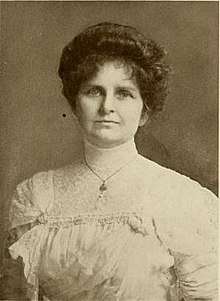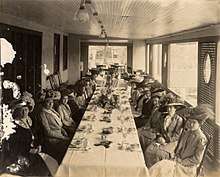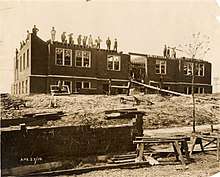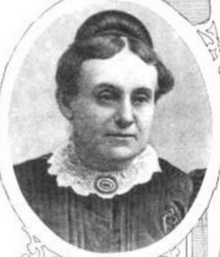M. Louise Thomas
M. "Minnie" Louise Russell Thomas (1861-1947) was the founder of Lenox Hall, a girls' school in St. Louis.

Early life
M. "Minnie" Louise Russell was born in 1861, the daughter of Judge Thomas Allen Russell (1834-1921), who was for some years a judge of the Circuit Court in St. Louis, and Martha Louisa Lenoir (1831-1913). [1]
Born during the war in Columbia, Missouri, and coming to live in St. Louis while a little girl, Louise Russell was educated in the public schools and graduated from the High School. The graduating exercises were held in a hall so spacious as to make it difficult to hear the essays, and the entertainment naturally became very monotonous to the audience. Russell said to herself, "when my turn comes I will make them hear me," and she did. Her clear and well-modulated voice at once attracted the attention of the guests and she was well rewarded, for the applause was so great as to call for an encore. That was the beginning of her success as a speaker. Her gift was much in demand in public and social life. [1]
Russell attended the University of Missouri, where she won the gold medal awarded by the Press Association at their annual meeting for the greatest excellence in oratory. This was the first occasion which presented itself for asserting her belief for equal rights for women. The boys preferred to have two gold medals awarded, one for them and another for the girls, making the contests separate and apart. An indignation meeting was held by the girls. Having been subjected to the same rules they could see no reason for discrimination, wanting to come in on an equal footing on this competition as well as on the examinations. The rules were made over and the privilege granted. The winner was Minnie Louise Russell. She believed that all women should be permitted to enter any field of labor or study for which they feel fitted. [1]
Career

Lenox Hall, a high-grade resident and day school for girls and young women, was established by M. Louise Thomas, the principal, in September 1907. The architects who were chosen for the great new Cathedral, Barnett, Haynes & Barnett designed the new Lenox Hall, in University City, and it was a perfect type of home for a girls' school. It was early English in type, and the entire building, together with its location—giving a broad range of the open country—leaves nothing to be desired in providing ideal surroundings for the students. [1]
On coming to St. Louis to establish a school, a name could not be decided upon, and it was while walking with her father, discussing the question, that they came upon Lenox Place—a beautiful residence portion of the city. "Here" she said, "is a name, suitable, musical and short, and if it stands for someone great and good, we will adopt it." Referring to the encyclopedia it was found that James Lenox was an American bibliophilist and philanthropist, founder of the Lenox Library in New York City for public reference, built in 1870. Later this was combined with the Astor and Tilden Libraries as the New York Public Library. [1]

While Thomas was married every luxury and comfort was hers, but when it became necessary to support herself and two daughters, she obtained a position to teach in Hardin College and Conservatory of Music, Mexico, Missouri, where she could keep her children with her. There she established the course of lectures to girls which she calls "Round Table Talks" and which were continued in her school. Not being able to reach each girl individually in the classroom, she gave them the privilege of coming to her at stated times to talk over questions and matters which worried or puzzled them, such as morals, ethics, rules for social life, attitude toward those who were inclined to bad habits, etc. [1]
Remaining in the school for six years she felt that conditions made it advisable to enter a field of work where her ideals for girls' education could have freer scope. Two offers were made her, one to take charge of a girls' school in Montana, and another in St. Louis. She refused both— entertaining the idea of establishing such a one as would enable her to carry out her plans unrestrictedly. About that time Martha H. Matthews, who had been a very successful principal of Hosmer Hall in St. Louis, died, and she felt that this was her opportunity for establishing a school for girls. [1]
Without a pupil registered or one promised, she went ahead and opened Lenox Hall, engaging a splendid faculty and arranging a course of study covering all grades of college preparatory work; also selected a graduate of Pratt Institute for a full course in domestic science; established a full art course under competent teachers, and engaged instructors for piano, voice and violin. [1]
It was a daring thing to do, but she looked into the future and believed there would be a demand for such a school in this growing metropolis. Success came from the start. Every year it was necessary to add to the capacity of the institution, several buildings being rented to accommodate the resident pupils, until from the old home on Taylor and McPherson, the last move was made to the beautiful new building in University City, planned and devised in every detail by Thomas herself. Some discouraging experiences were hers after deciding to build this new school; she went to bankers, trust companies, rich women, and to everyone whom she thought might be influenced to build such a one as she would require, but not a single word of encouragement, satisfaction or assistance could she obtain until Mrs. Edward Gardner Lewis, the president of the American Woman's Republic (AWR), interested her husband, and he made it possible to carry out her plans. [1]

Lenox Hall accommodated thirty-seven students and offered all the advantages of a country home to its pupils while enjoying the many opportunities for culture of a school in a large city. [1]
The aim of Thomas was to establish a relation of friendship between teacher and pupil, as well as to develop ideals which will be of lasting influence in building up a cultured and refined womanhood. In large institutions general classifications and uniform demands are imperative, but in the small private school it was possible for each pupil to have such individual attention that her instruction was adapted to her especial needs, and her mental and physical growth stimulated and encouraged by a healthful and normal process. [1]
It was impossible to cast all minds in one mold, to measure all by one standard. Each individual was a separate entity with individual insufficiencies and needs, and ought to have training suited to such needs, also the attention that awakens dormant talent and the power of right thinking which determines right living. [1]
Lenox Hall was affiliated with University of Missouri–St. Louis, Washington University in St. Louis, Wellesley College, Smith College, and other colleges of the East and South admitting women. Much individual work was done teaching students to analyze, systematize, and correlate their work; suggestive talks were given on the value of concentration, accurate and independent thinking, sustained attention, etc. [1]
The course of study prescribed by Thomas was elastic and the methods of teaching vary each year according to age, development, tastes and interest of the pupils. She believed that "what we teach has higher ends than merely being taught and learned," and held that the supreme end of education was the formation of character, therefore all subjects were dealt with vitally and with relation to the life of the individual pupil, whose sense of responsibility was thus awakened and gradually developed so that the foundation was laid upon which to build a future, well-ordered, satisfying life. Thomas laid much stress upon the moral as well as the religious training of the girls under her care. [1]
Right thinking as well as right living was the basic principle of character building. Truth, "from within, out," sincerity, lofty ideals, and unselfish sympathy with one's fellow beings is the spirit she tried to inculcate. [1]
Realizing the importance of definite training of the social instincts and the necessity of affording maturing womanhood an opportunity to exercise the natural tendencies of her social being, Thomas endorsed various forms of entertainment by which the young girl may learn the grace and charm which characterizes "gentle womanhood," and which gave every opportunity for enjoyment, instruction and means of acquiring ease and grace of manner in conversation. She believed that social training was essential in the development of poise, and in the cultivation of the faculty of being interested in things—the best things. It was the means whereby the facts of scholarships were translated into terms of life and the individual developed into an active, efficient social unit. Just as growth was secured by cultivation so was development made sure by expression. [1]
Social training was the means for the expression of education; it was the opportunity for "applied culture," and was as essential a factor in the development of an effective personality as was the storing up of facts which in themselves made but a "dead scholarship." Thomas also advocated the study of languages as being a decided advantage to every woman. [1]
The editor of The World's Work issued a Hand Book of Schools in 1912 as a guide to parents considering the school question. Thomas was requested to contribute one of the two articles allotted to schools for girls only; the others being written by such men as professors of Columbia University, editors of magazines, presidents of well-known schools, etc. She contributed frequently to magazines and periodicals, both prose and poetry, and one of the poems which she sent out as a New Year's greeting to the patrons of the school was adopted by the president of the Mothers' Congress of Texas to send to members of the different branches throughout the State as her greeting for 1913, being printed very neatly in booklet form. [1]
It was the custom of the principal of Lenox Hall to entertain, at intervals, house guests of distinction and recognized culture, giving the pupils the opportunity of coming into close personal touch with men and women whose wealth of experience and achievement was an inspiration. Many of the principal educators of Eastern colleges, as well as authors of note, enjoyed this courtesy—among them James Monroe Taylor, 4th president of Vassar College; Ruth McEnery Stuart; Bertha Kunz-Baker; Florence Howe-Hall, daughter of Julia Ward Howe; Belva A. Lockwood; Samantha A. Huntley; Alfred D'Orsay Tennyson Dickens. [1]
As an educator Mrs. Louise Thomas ranked among the best. She was highly cultured, and was gracious and charming in manner. Her strong personality endeared her to all of her pupils. [1]
In 1888, M. Louise Thomas served as a founding member and officer of the National and International Council for Women alongside Susan B. Anthony. [2]
Personal life

M. Louise Russell married J.D. Thomas and had three children: Russell A. Thomas (died in 1895), Raydell T. Watson (1891-1974) and Louise Le Noir Thomas. Louise Le Noir Thomas followed her mother example as an advocate of women's suffrage and a member of the Equal Suffrage League of St. Louis. She attended Smith College and engaged in a variety of athletic pursuit. After college she became a writer and worked in advertising and advocated for women's self-defense as an extension of the quest for political equality. [2]
M. Louise Thomas died in 1947, and is buried at Bellefontaine Cemetery, Saint Louis.
NOTE: This article partially conflates M. Louise Russell Thomas with Maria Louise Palmer Thomas (1825-1907),who was born in Mount Holly, New Jersey, raised in Pottsville, Pennsylvania, and who married Universalist minister Abel C. Thomas. This Louise was an intimate friend of Abraham Lincoln, Edwin M. Stanton, P.T. Barnum, and Susan B. Anthony. In 1867, the Thomases purchased the 20-acre estate of Thomas Lloyd Wharton in the Tacony neighborhood of Philadelphia, PA. Among achievements too numerous to mention here (see Tacony: Era of William H. Gatzmer and the Philadelphia & Trenton Railroad (2015) by Charles A. McCloskey), Louise founded a Tacony chapter of the women's organization, Sorosis, conceived of the idea for a library for the growing community of Tacony (which endures today as the Tacony branch of the Free Library of Philadelphia), and served as secretary of the National Council of Women while Susan B. Anthony was vice-president. The photo appearing to the right, here, is of this M. Louise Thomas, not "Minnie."
References
- Johnson, Anne (1914). Notable women of St. Louis, 1914. St. Louis, Woodward. p. 230. Retrieved 17 August 2017.

- Rouse, Wendy L. (2017). Her Own Hero: The Origins of the Women’s Self-Defense Movement. NYU Press. p. 124. Retrieved 1 September 2017.